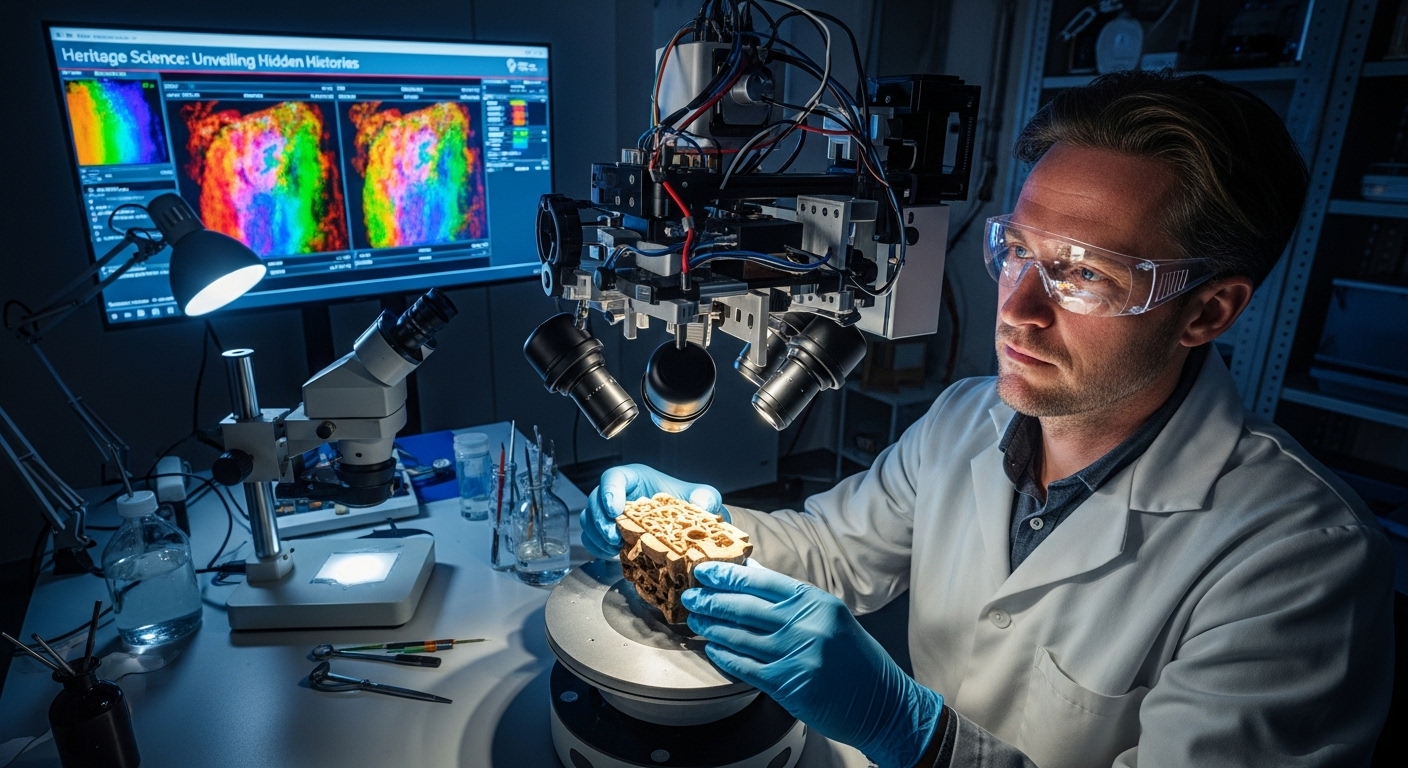Professor Jeroen Dik represents a revolutionary force in cultural heritage research, combining materials science with cutting-edge imaging technology. Furthermore, his work at Delft University of Technology has transformed how scientists and historians study historical artworks today. The professor pioneered macro X-ray fluorescence scanning, revealing hidden paintings and artistic processes invisible for centuries before now. Moreover, his innovative methods bridge scientific analysis with art historical research, creating unprecedented insights into masterpiece creation. Subsequently, museums worldwide now employ his techniques to preserve and interpret their collections with remarkable precision and care.
Academic Foundation and Interdisciplinary Approach
Educational Background and Expertise
The professor built his career on rigorous training in materials science, analytical chemistry, and engineering at leading institutions. Additionally, his interdisciplinary perspective combines physics, chemistry, and art history into comprehensive research methodologies for heritage studies. This unique blend enables him to address complex conservation challenges that single-discipline approaches cannot solve effectively today. Consequently, his academic foundation supports innovative thinking that pushes boundaries in both scientific and cultural domains simultaneously.
Research Philosophy and Vision
His research philosophy emphasizes non-invasive analysis, ensuring artworks remain undamaged while yielding maximum scientific information about composition. Furthermore, he believes technology should serve cultural understanding, making scientific discoveries accessible to broader audiences beyond academia. Collaboration forms a cornerstone of his approach, bringing together engineers, conservators, historians, and museum professionals productively. Therefore, this inclusive vision creates research outcomes that benefit multiple stakeholders and advance knowledge across diverse fields.
Revolutionary Imaging Technologies
Macro X-Ray Fluorescence Scanning Innovation
The professor gained international fame by developing macro-XRF scanning techniques that map chemical elements across entire paintings. Moreover, this technology reveals hidden compositions, underdrawings, and artistic changes that previous methods could never detect accurately. The scanning process creates elemental maps showing where specific pigments appear throughout artwork layers at high resolution. Subsequently, researchers can visualize complete creative processes, understanding how artists developed their masterpieces through successive modifications over time.
Three-Dimensional Reconstruction Methods
His team creates layered 3D visualizations that allow viewers to explore paintings virtually, examining each compositional layer separately. Additionally, these reconstructions help conservators understand how materials interact, age, and degrade within complex multilayered painting structures. Digital models enable non-destructive analysis of depth, thickness, and material distribution throughout artworks without physical sampling required. Consequently, conservation planning improves dramatically through comprehensive understanding of artwork structure before any restoration work begins.
Spectroscopic Analysis Techniques
Advanced spectroscopy methods analyze molecular composition across different wavelengths, identifying specific pigments and binding materials accurately. Furthermore, hyperspectral imaging captures information invisible to human eyes, revealing details about manufacturing processes and material sources. These techniques work synergistically with XRF scanning, providing complementary data that creates complete pictures of artwork composition. Therefore, multi-modal analysis delivers insights far exceeding what any single technology could achieve independently in research.
Landmark Discoveries and Breakthroughs
Hidden Rembrandt Portrait Revelation
One celebrated discovery involved uncovering a complete portrait hidden beneath a known Rembrandt painting using macro-XRF technology. Moreover, the analysis revealed the artist’s decision-making process, showing how he modified compositions during creative development phases. This finding made international headlines, demonstrating scientific methods’ power to transform art historical understanding through technological innovation. Subsequently, the discovery attracted widespread media attention, raising public awareness about heritage science’s importance in culture.
Van Gogh Masterpiece Analysis
Research on Van Gogh paintings revealed how the artist experimented with pigment mixing and layering techniques uniquely. Additionally, hidden sketches and compositional changes showed his evolving artistic vision and technical approach throughout different periods. The analysis identified specific pigments that degrade over time, informing conservation strategies to prevent further deterioration effectively. Consequently, these findings help museums preserve Van Gogh’s legacy while deepening appreciation for his innovative techniques.
Dutch Golden Age Painting Studies
Extensive research on seventeenth-century Dutch paintings uncovered widespread practices of reusing canvases and modifying existing compositions. Furthermore, these discoveries revealed economic constraints, workshop practices, and collaborative processes among master painters and their assistants. Technical analysis showed how pigment availability influenced artistic choices and stylistic development during this remarkable period. Therefore, scientific investigation illuminates historical context beyond what traditional art history alone could establish definitively today.
Museum Partnerships and Collaborative Projects
Rijksmuseum Research Initiatives
Close collaboration with the Rijksmuseum enables comprehensive analysis of masterpieces from their world-renowned collection of Dutch art. Moreover, joint projects develop new conservation protocols based on scientific understanding of material behavior and degradation patterns. The partnership combines museum expertise with university research capabilities, creating synergies that benefit both institutions significantly. Subsequently, findings inform exhibition planning, conservation priorities, and educational programming that engages millions of visitors annually.
International Conservation Networks
The professor maintains active collaborations with conservation laboratories across Europe and North America, sharing methodologies and findings. Additionally, these networks facilitate comparative studies of artworks in different collections, revealing broader patterns in technique. International partnerships accelerate technology development through pooled resources and diverse expertise from multiple research traditions worldwide. Consequently, global cooperation advances heritage science faster than isolated efforts could achieve independently within single institutions.
Technology Transfer to Museums
Research outcomes translate into practical tools that museums can deploy for routine conservation assessment and planning. Furthermore, training programs teach conservators to operate advanced equipment and interpret complex scientific data for practical applications. Portable scanning devices now enable on-site analysis without transporting fragile artworks to specialized laboratories for testing. Therefore, technology democratization extends advanced capabilities to institutions worldwide, regardless of size or resources available locally.
Conservation Science Contributions
Pigment Identification and Analysis
Precise identification of original pigments helps conservators select appropriate restoration materials that match historical compositions authentically. Moreover, understanding pigment chemistry reveals manufacturing sources, trade routes, and economic factors influencing artistic production historically. This knowledge prevents misguided restorations that introduce anachronistic materials incompatible with original techniques and aesthetic intentions. Subsequently, scientifically informed conservation preserves artistic integrity while ensuring physical stability for future generations to appreciate.
Degradation Monitoring Systems
Advanced imaging tracks subtle changes in artwork condition over time, detecting deterioration before visible damage appears. Additionally, environmental monitoring correlates degradation rates with temperature, humidity, light exposure, and other factors affecting preservation. Predictive models help museums optimize display conditions, balancing public access with long-term conservation requirements effectively today. Consequently, proactive management prevents irreversible damage while extending artwork lifespans significantly through informed environmental control.
Restoration Planning and Validation
Non-invasive analysis informs restoration decisions by revealing original compositions hidden beneath later additions or previous restoration attempts. Furthermore, post-restoration scanning validates treatment effectiveness and documents interventions for future reference by conservation professionals worldwide. This documentation creates permanent records of artwork condition and treatment history, supporting long-term stewardship responsibilities. Therefore, comprehensive scientific documentation improves restoration outcomes while building institutional knowledge that benefits future conservation efforts.
Academic Leadership and Education
Course Development and Teaching
The professor designs innovative courses that teach materials characterization, analytical methods, and heritage science to engineering students. Moreover, interdisciplinary seminars bring together students from different departments, fostering collaborative thinking essential for heritage research. Hands-on laboratory experiences give students direct exposure to advanced instruments and real-world conservation challenges today. Subsequently, graduates enter careers equipped with unique skill combinations that industries and museums increasingly demand worldwide.
Student Mentorship and Supervision
Active mentorship guides graduate students through complex interdisciplinary research projects requiring technical expertise and cultural sensitivity. Additionally, the professor encourages students to present findings at international conferences, building professional networks early in careers. Thesis supervision emphasizes rigorous methodology while supporting creative approaches to challenging problems in heritage science applications. Consequently, mentored students develop into independent researchers who advance the field through their own innovative contributions.
Building Interdisciplinary Research Culture
Leadership efforts create collaborative environments where engineers, historians, chemists, and conservators work together productively on projects. Furthermore, regular seminars, workshops, and symposia facilitate knowledge exchange across disciplinary boundaries within university communities. This culture attracts talented researchers from diverse backgrounds, creating vibrant intellectual ecosystems supporting groundbreaking discoveries. Therefore, institutional culture-building multiplies individual research impacts through collective intelligence and shared resources available.
Publications and Scholarly Impact
Peer-Reviewed Research Articles
Extensive publication record in prestigious journals disseminates findings to scientific communities and establishes methodological standards broadly. Moreover, highly cited papers demonstrate research influence across materials science, analytical chemistry, and cultural heritage domains. Technical publications provide detailed protocols that other researchers can replicate, accelerating global progress in methodology. Subsequently, scholarly communication ensures discoveries benefit the entire scientific community rather than remaining isolated within institutions.
Book Chapters and Review Articles
Comprehensive review articles synthesize research progress, identifying gaps and proposing future research directions for the field. Additionally, book chapters make technical knowledge accessible to broader audiences including students, conservators, and museum professionals. These publications bridge specialist research with practical applications, ensuring scientific advances inform conservation practice effectively today. Consequently, diverse publication formats reach multiple audiences, maximizing research impact across different professional communities worldwide.
Conference Presentations and Invited Lectures
Regular presentations at international conferences share latest findings while establishing the professor as thought leader in heritage science. Furthermore, invited lectures at museums, universities, and cultural institutions raise public awareness about scientific contributions to preservation. These engagements build networks that facilitate collaborative projects and position research within broader cultural conversations globally. Therefore, active scholarly engagement extends influence beyond publications, shaping research agendas and conservation priorities internationally.
Recognition and Professional Honors
Scientific Awards and Distinctions
The professor has received numerous awards recognizing groundbreaking contributions to materials science and cultural heritage research fields. Moreover, election to prestigious scientific societies acknowledges sustained excellence and leadership within professional communities over decades. These honors validate innovative methodologies and encourage continued research pushing boundaries in heritage science applications today. Subsequently, recognition attracts funding, collaboration opportunities, and talented researchers to ongoing projects at the university.
Media Coverage and Public Engagement
Research discoveries frequently attract international media attention, appearing in documentaries, news reports, and popular science publications. Additionally, public lectures and museum exhibitions make scientific work accessible to general audiences interested in art. This visibility demonstrates research relevance beyond academia, building public support for continued investment in heritage science. Consequently, effective communication strengthens connections between scientific communities and societies they serve through cultural preservation efforts.
Future Research Directions
Portable Technology Development
Ongoing work develops portable scanners that museums can use on-site, eliminating risks associated with transporting fragile artworks. Furthermore, miniaturization and cost reduction will democratize access to advanced imaging capabilities for smaller institutions worldwide. Mobile technology enables field research in remote locations where fixed laboratory equipment cannot reach effectively today. Therefore, portability expansion promises to multiply research impacts by making tools accessible wherever cultural heritage requires study.
Artificial Intelligence Integration
Machine learning algorithms will automate data analysis, identifying patterns and anomalies across massive datasets beyond human processing. Additionally, AI systems will assist in pigment identification, dating artwork components, and detecting forgeries with unprecedented accuracy. These computational tools will accelerate research timelines while improving analytical precision significantly in coming years ahead. Subsequently, artificial intelligence integration represents the next frontier in heritage science technological evolution and capability enhancement.
Digital Heritage Preservation
Creating comprehensive digital twins of artworks enables virtual study, conservation planning, and public engagement through online platforms. Furthermore, 3D models preserve artwork states permanently, documenting conditions for future researchers regardless of physical deterioration. Virtual reality applications will allow immersive exploration of hidden layers and artistic processes in educational contexts. Consequently, digital preservation complements physical conservation, ensuring cultural heritage remains accessible despite inevitable material changes over time.
Conclusion and Lasting Legacy
Professor Jeroen Dik’s pioneering work fundamentally transformed how scientists, museums, and the public understand and preserve cultural heritage. Furthermore, his innovative imaging technologies revealed hidden artistic processes that enriched art historical knowledge immeasurably across collections. The interdisciplinary approach he championed demonstrates how combining diverse expertise yields insights unattainable through single disciplines alone. Moreover, extensive collaborations with museums worldwide ensure research discoveries directly benefit conservation practice and public cultural understanding. Subsequently, his legacy extends beyond individual discoveries to encompass methodologies, educational programs, and collaborative networks sustaining progress. Therefore, future generations will continue building upon foundations he established, advancing heritage science while preserving humanity’s artistic treasures. Ultimately, this remarkable career exemplifies how scientific innovation serves cultural preservation, bridging past and future generations.

